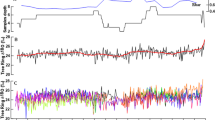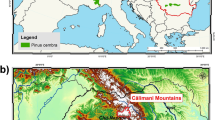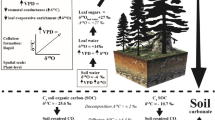Abstract
The climatic significance of the stable-isotope ratio of hydrogen (δD) in tree cellulose has been demonstrated using data mainly from coniferous trees that grew in temperate climates1–4. In such regions, the mean annual δD of precipitation is linearly related to the mean annual temperature5, and trees thriving on precipita-tion preserve this temperature signal in the δD of the carbon-bound hydrogen of cellulose in their growth rings. Similar studies on tropical deciduous trees could yield useful information on climate, such as the monsoon variability over the past few centuries. However, because of the small summer-to-winter temperature con-trast, tropical trees grow throughout the year and hence do not lay down well-defined growth rings (even in the few species with clear rings, it is difficult to ascertain if they are annual6). Also, throughout the year tropical mean surface air temperatures are >20 °C, above which the linear relation between δD of precipita-tion and temperature breaks down7. Thus there is no temperature signal in the δD of precipitation for the trees to record. In spite of these problems, we report here a significant correlation (0.7) between δD variations in two individual teak trees from the west coast of India with the amount of rainfall and mean maximum temperature, as in the case of temperate trees4. We propose a mechanism whereby δD of teak tree cellulose is correlated with amount of rainfall.
This is a preview of subscription content, access via your institution
Access options
Subscribe to this journal
Receive 51 print issues and online access
$199.00 per year
only $3.90 per issue
Buy this article
- Purchase on Springer Link
- Instant access to full article PDF
Prices may be subject to local taxes which are calculated during checkout
Similar content being viewed by others
References
Yapp, C. J. & Epstein, S. Geochim. cosmochim. Acta 46, 955–965 (1982).
White, J. W. C., Cook, E. R., Lawrence, J. R. & Broecker, W. S. Geochim. cosmochim. Acta 49, 237–246 (1985).
Ramesh, R., Bhattacharya, S. K. & Gopalan, K. Nature 317, 802–804 (1985).
Ramesh, R., Bhattacharya, S. K. & Gopalan, K. Earth planet. Sci. Lett. 79, 66–74 (1986).
Dansgaard, W. Tellus 16, 436–468 (1964).
Fritts, H. C. Tree Rings and Climate (Academic, London, 1976).
Joussaume, S., Sadourny, R. & Jouzel, J. Nature 311, 24–29 (1984).
Chowdhury, K. A. Indian Forest Records 2, 59–75 (1940).
Troup, R. S. The Silviculture of Indian Trees Vol. 2 (Clarendon Press, Oxford, 1921).
Pant, G. B. & Borgaonkar, H. P. in Environmental Management (eds Singh, L. R. et al.) 153–158 (Allahabad Geographical Society, Univ. Allahabad, India, 1983).
Gray, J. & Song, S. J. Earth planet. Sci. Lett. 70, 129–138 (1984).
Ramesh, R. thesis, Univ. Gujarat (1984).
Gonfiantini, R. IAEA Report to the Director General, 2 (1983).
Mitchell, J. M. Jr WMO Tech. Note 79, 79 (1971).
Author information
Authors and Affiliations
Rights and permissions
About this article
Cite this article
Ramesh, R., Bhattacharya, S. & Pant, G. Climatic significance of δD variations in a tropical tree species from India. Nature 337, 149–150 (1989). https://doi.org/10.1038/337149a0
Received:
Accepted:
Issue Date:
DOI: https://doi.org/10.1038/337149a0
This article is cited by
-
Tree-ring variation in teak (Tectona grandis L.) from Allapalli, Maharashtra in relation to moisture and Palmer Drought Severity Index, India
Journal of Earth System Science (2011)
-
Dendroclimatology and climate change: Indian perspective
Journal of the Indian Academy of Wood Science (2011)
-
Intra-annual variations of teak cellulose δ18O in Kerala, India: implications to the reconstruction of past summer and winter monsoon rains
Climate Dynamics (2011)
-
Tree-ring analysis of teak (Tectona grandis L.F.) in central India and its relationship with rainfall and moisture index
Journal of Earth System Science (2008)
-
Records of climatic changes and volcanic events in an ice core from Central Dronning Maud Land (East Antarctica) during the past century
Journal of Earth System Science (2002)
Comments
By submitting a comment you agree to abide by our Terms and Community Guidelines. If you find something abusive or that does not comply with our terms or guidelines please flag it as inappropriate.



